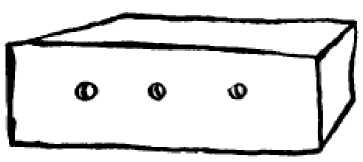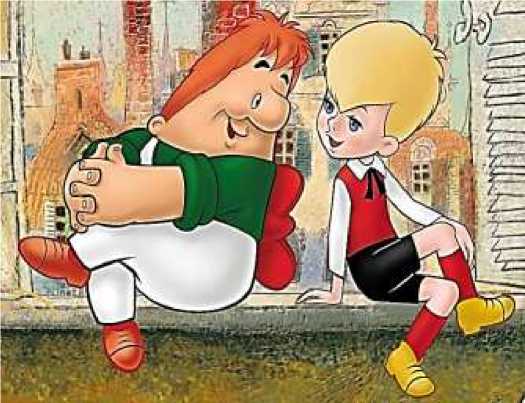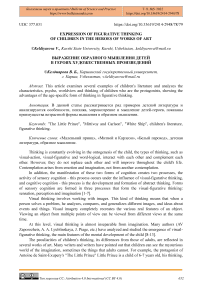Expression of figurative thinking of children in the heroes of works of art
Автор: Keldiyarova Vazira
Журнал: Бюллетень науки и практики @bulletennauki
Рубрика: Педагогические науки
Статья в выпуске: 5 т.8, 2022 года.
Бесплатный доступ
This article examines several examples of children's literature and analyzes the characteristics, psyche, worldview and thinking of children who are the protagonists, showing the advantages of the age-specific form of thinking in figurative thinking.
The Little Prince, Mittivoy and Carlson, White Ship, children's literature, figurative thinking
Короткий адрес: https://sciup.org/14124407
IDR: 14124407 | УДК: 377.031 | DOI: 10.33619/2414-2948/78/79
Текст научной статьи Expression of figurative thinking of children in the heroes of works of art
Бюллетень науки и практики / Bulletin of Science and Practice
UDC 377.031
Thinking is constantly evolving in the ontogenesis of the child, the types of thinking, such as visual-action, visual-figurative and word-logical, interact with each other and complement each other. However, they do not replace each other and will improve throughout the child's life. Contemplation arises from emotion and imagination, not from another contemplation.
In addition, the manifestation of these two forms of cognition creates two processes, the activity of sensory cognition - this process occurs under the influence of visual-figurative thinking, and cognitive cognition - this process is the development and formation of abstract thinking. Forms of sensory cognition are formed in three processes that form the visual-figurative thinking: sensation, perception and imagination [1-7].
Visual thinking involves working with images. This kind of thinking means that when a person solves a problem, he analyzes, compares, and generalizes different images, and ideas about events and things. Visual imagery completely recreates the various real features of an object. Viewing an object from multiple points of view can be viewed from different views at the same time.
At this level, visual thinking is almost inseparable from imagination. Many authors (AV Zaporozhets, A. A. Lyublinskaya, J. Piage, etc.) have analyzed and studied the emergence of visual-figurative thinking, the main features of the mental development of the child [8-13].
The peculiarities of children's thinking, its differences from those of adults, are reflected in several works of art. Many writers and writers have pointed out that children can see the mysterious world of the imagination, sometimes the things that adults cannot. For example, the protagonist of Antoine de Saint-Exupery's "The Little Prince" Little Prince is a child of 6-7 years old, his thinking, worldview, curiosity, innocence and simplicity are very skillfully expressed in other aspects of children [12-15]. The author has artistically demonstrated that children's thinking differs from that of adults in that they fully and completely accept what they see without comparative analysis or clarification, even from angles that adults cannot see. Take this picture from the work, for example:

Figure 1. Drawing of a suffocating snake that swallowed an elephant (the hero of the work drew at the age of 6).
The protagonist claims that the pilot drew the picture when he was 6 years old, depicting a rattlesnake that swallowed an elephant, but when he showed it to adults, they said it was just a hat and it was not scary. But the author believes that children understand this picture better than adults and accept it as much as possible because they do not calculate whether the snake can swallow the elephant.

Figure 2. Drawing of a suffocating snake that swallowed an elephant
Another scene in the play is remarkable: The little prince asks the pilot to draw a lamb, but he does not like the drawn lamb. The pilot then draws a simple box and says, "Here's the lamb you want."

Figure 3. A picture of a lamb in a box
This is very pleasing to the Little Prince, who even says, "I needed just that."
She imagines the lamb she needs in this box. It is a masterful representation of children's imaginative thinking from the writer's domain [2]. Hans Christian Andersen's fairy tales "Snow Queen" and "Nightingale", which have made a significant contribution to world children's literature, also emphasize the image of children. The protagonists of these fairy tales, in particular, depict the image of children in such a way that they describe the characteristics of all children, their worldview, dreams and fantasies, innocence, love of peace and beauty, and constant striving for good. The story of the Nightingale tells the story of a very small and friendly nightingale in China, whose description of the magnificent bird has spread to seven worlds, but whose palace and officials are unaware of it. The whole palace can't find the bird, but a servant boy shows them where the nightingale lives. Gives it very nice qualities and descriptions. When officials saw the nightingale with their own eyes, they concluded that it was very ugly and unsuitable for the palace. Meanwhile, an artificial "nightingale" is brought from the neighbouring country to the emperor of China as a gift. It was very beautiful, adorned with precious stones, and could sing like a nightingale. But despite these qualities, the servant boy insists that a real nightingale is still better. The writer can see that this servant child is able to see qualities that others, that is, adults, cannot, and thus express the imagination of children's minds and emotions [4-9].
Kay, Gerda, and Andersen's "Snow Queen," the protagonists of the fairy tale, also express feelings of progress, loyalty, kindness, compassion, and friendship, despite opposition from adults. It is noteworthy that Gerda's courage, fearlessness, and ingenuity set an example for other children. In Astrid Lindgren's Kid and Carlson, Kid is as simple as any of the above and is interpreted as a child. But children's inner worlds, thoughts and imaginations are expressed in a childlike way. If we take the scene of Kid's acquaintance with Carlson, Kid is a child of 6-7 years old, and because of his age, he has the ability to think as he perceives the world. He was not afraid to befriend her. He did not make any observations to find out where he came from or where he came from. He accepted her as Carlson, who lived on the roof. This is because of the way children think.

Figure 4. The protagonists of Astrid Lindgren's Kid and Carlson
One of the masterpieces of world literature is the image of a child in the story "White Ship" by the brotherly Kyrgyz writer Chingiz Aitmatov. This work is similar to The Little Prince in that it illuminates the child's imagination and thinking about his experiences and psyche, and is philosophical and tragic. But the plot is radically different [3]. The protagonist is a white ship with an eternal dream and a toy of an out-of-school child around the age of 7. She really wants to go on a white ship and see her father. However, it is difficult to sail to the ship, so he dreamed of becoming a fish, so that all parts of the fish: body, tail, fins, coins would pass to him, but only a thin neck, a turtle, a scratched nose. If it remains alive. Keep your eyes peeled. But let them see it as real fish, not as it is now. In this passage, the child imagines how to become a fish and what it will be like. He imagines himself as a fish. The play also features the child's toys and strange playing stones, which the child himself named. These are: "wolf", "camel", "saddle", "tank", "brave", "beloved", "scornful" and even "cunning". The child gives these stones such symbolic names that they resemble the shapes of animals and objects that exist in the reality he sees.
This is a situation that is often observed by children in our daily lives. This is part of the child’s thinking. He creates new images in his imagination. Communicates with them. The believer is so moved by the old man's tales that he believes that the horned mother deer carries a cradle in its golden horns. In his story, the author uses these features of children with a deep understanding and reveals the image and psyche of the child [3].
Only by understanding these characteristics of children can works about they be very successful. We often find such works in Uzbek literature. We can find many such examples in "Riding the Yellow Giant", "The Land of Sweet Melons", "The Silent Child", "Ice Cream" and many others.
From the above analysis, it can be concluded that the interpretation of children described in literary works describes their age-specific characteristics, psychology, imagination, worldview, and thinking. The qualities and experiences of the children's characters, taken and copied from life, show that they are connected with reality as individuals. These works make it easier to better understand, study and analyze children's characteristics. Through the examples we have given, we have tried to reveal the figurative thinking of children, to make a broader observation.
Acknowledgements: The authors acknowledge the immense help received from the scholars whose articles are cited and included in references to this manuscript. The authors are also grateful to the authors/ editors/publishers of all those articles, journals and books from where the literature for this article has been reviewed and discussed.
The authors report no conflicts of interest.
Список литературы Expression of figurative thinking of children in the heroes of works of art
- Antuan de Sent-Ekzyuperi (2016). Kichkina Shahzoda. Ertak. Toshkent.
- Astrid Lindgren (2016). Mittivoy va Karlson. Ertak. Toshkent.
- Chingiz Aytmatov (2018). Oq kema. Qissa. Toshkent.
- Hans Kristian Andersen. (2007). Bulbul/Qor malikasi. Ertaklar. Toshkent.
- Ivanov, P. I., & Zufarova, M. E. (2015). Umumiy psixologiya. Toshkent.
- Keldiyarova, V. B. (2020). Bolalarning qobilyatlarini erta aniqlashda obrazli tafakkurning ahamiyati. In Innovatsionnye podkhody v sovremennoi nauke, (pp. 50-54).
- Vygotskii, L. S. (2016). Voprosy detskoi psikhologii. St. Petersburg. (in Russian).
- Baryshnikova, E. V. (2018). Psikhologiya detei mladshego shkol'nogo vozrasta. Chelyabinsk. (in Russian).
- Keldiyarova, V. (2021). Ijodiy faoliyat jarayonida obrazli tafakkurni rivojlantirish metodlari. Obshchestvo i innovatsii, 2(8/S), 475-479.
- Lyublinskaya, A. A. (1971). Detskaya psikhologiya. Moscow. (in Russian).
- Piazhe, Zh. (1999). Rech' i myshlenie rebenka. St. Petersburg. (in Russian).
- Abduqodirov, A. A. (2015). Cases from pedagogy and Psychology and methods of their use. Toshkent.
- Oripova, N. (2021). Bo ‘lajak mutaxassislarda kasbiy e’tiqodni shakllantirish bosqichlari. Obshchestvo i innovatsii, 2(2/S), 525-529.
- Ashurova, T. E. (2016). Professional'naya deyatel'nost' sovremennogo vospitatelya. Zhurnal nauchnykh publikatsii aspirantov i doktorantov, (9), 69-70. (in Russian).
- Oripova, N. & Ashurova, S. (2018). Aspects of formation worldview of pre-school age children. Bulletin of Science and Practice, 4 (2), 409-413. (in Russian).


